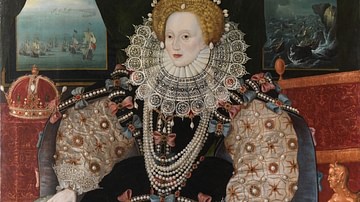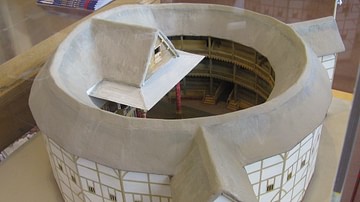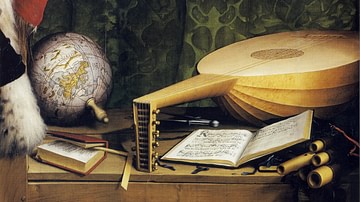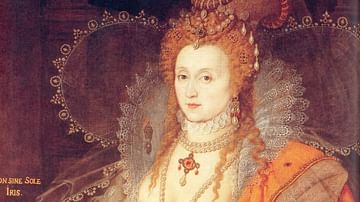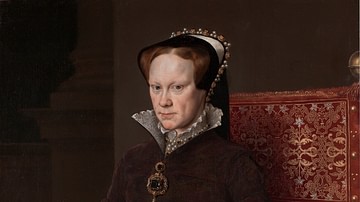Food and drink in the Elizabethan era was remarkably diverse with much more meat and many more varieties of it being eaten by those who could afford it than is the case today. Storage of food was still a problem and so fresh produce was grown at home or regularly acquired at local markets. Thick sauces with strong flavours were popular and made even more varied as ingredients became more readily available from Asia. Pastries, cakes, and other sweet goodies of all kinds were greatly appreciated and often eaten between the savoury courses. A healthy distrust of water meant that ale and beer were the most popular drinks, with wine a welcome addition for the better off. While some commoners struggled, as ever, to feed their families, especially in the long winters of the 16th century CE, foreign visitors did often remark on how well-fed the Elizabethan peasantry was and how overfed the rich were compared to their continental neighbours.
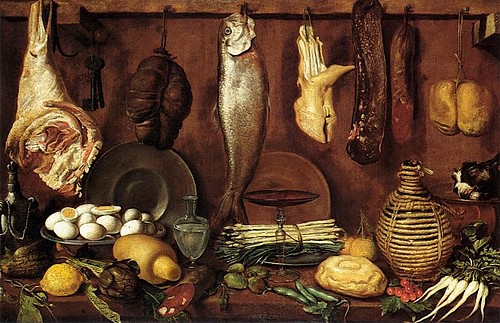
Cooking & Storage
Most Elizabethan cooking was done at home but there were communal ovens in many parishes for people to take their prepared dough and have it baked into bread or to have a stew (pottage) slowly cooked. Those who could afford servants also had cooks, usually women but including men, too, at the great houses. Even the humblest of kitchens would have had such indispensable cooking and preparation aids as a large brass pot and iron pan, a spit for roasting over the fire, a milk pail and sundry containers, utensils and serving dishes for food made of wood, clay or pewter. Most cooking was done over an open fire of wood or charcoal with a large pot either stood on legs actually in the fire or suspended over it using chains. The main methods of cooking were boiling, roasting, and frying. The fourth method was baking and involved putting the dish inside a closed oven made of clay or brick much like a wood-burning pizza oven today.
Larger households stored food in giant meal chests which were airtight and used to keep such goods as grain and preserved meat and fish. In contrast, hutches ('pantries') were boxes with air-holes for keeping fresh food like cheeses. In households with a staff of servants, these chests were often kept locked to prevent unauthorised nibbling. The vast majority of the population still worked in agriculture and often had their own small plot of land for their own personal needs. Indeed, even artisans who specialised in such activities as weaving and making clothes still kept a patch of land for their vegetable garden and some poultry. Local markets supplied everything else but the larger estates would have been more self-sufficient producing their own bread, milk, cheese, meat, and fish on site.
The Meals of the Wealthy
The wealthy were much more likely to have the time to eat a sit-down breakfast. The meal was not particularly different from those later in the day and might include porridge, bread, cheese, fruit and meat. The poorer classes would have just grabbed any leftovers from the night before or a chunk of bread and butter and been off to start their working day. The two main meals for everyone remained around 11 am to 12 noon and again from 6 to 9 pm. Snacks of bread, cheese, and cold food washed down with a cup of ale would have been taken any time in-between.
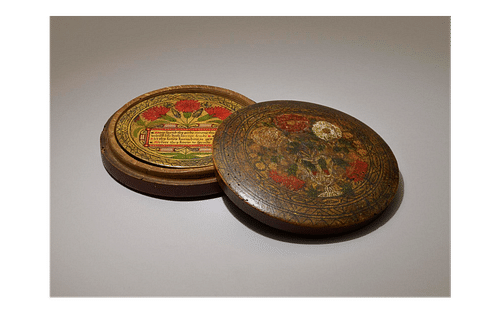
Perhaps the greatest difference between the diets of the upper classes and the lower classes was the quantity of meat the former group ate. Meat was fresh or, when eaten in the winter months, was preserved via salting, smoking, drying, or pickling. The latter methods were a necessity because animals were often slaughtered before the onset of winter as feeding them in that season was difficult. Cured hams and sausages were another way to keep meat edible through the winter.
Meat dishes on offer for those who could afford it included beef, veal, pork, lamb, mutton, and poultry such as chicken, duck, goose and pigeon. Game meat included rabbit, venison, woodcock, and many other types of birds from pheasants to cranes. Game was often protected by forest laws with strict punishments for poachers. Not much of an animal was ever wasted as dishes were made using trotters, feet, and heads. Fish was also a common dish and eaten wholly in place of meat during Lent (Protestant Elizabethan England kept up the practice to support fishermen). Common fish included cod, mackerel, and herring, with more expensive fish being salmon, trout, and pike amongst many others. Other seafood included eels, crustaceans, and shellfish (especially mussels, crab, shrimp, and oysters). Seafood was cheap in villages and towns on the coast or near rivers but was a luxury only for the rich in inland areas.
At special dinners, the guests could choose from a wide variety of meat dishes and even ask for a sample before making their decision. Flavours were added using spices, a handy extra that also hid the taste of salted or not quite top-grade meat. Flavours were added to sauces thickened with bread crumbs and included spices from the East Indies like pepper, cloves, cinnamon, and nutmeg, as well as ginger, hot peppers, saffron, garlic, and mustard, perhaps the most popular flavour of all for meat dishes, at least. Other commonly added flavours included salt, onions of all types, fennel, rocket, vinegar, olive oil, and such herbs as sage, parsley, thyme, and rosemary. Even flowers were tossed in to add their distinctive tastes and a splash of colour, for example, marigolds, violets, and primroses. Meat was frequently cooked in ale, almond milk, wine, and verjuice (the sour juice of crabapples). Stews using pieces of meat and fish were made with the above flavourings and spices added along with thickeners such as rice, barley, and oats.
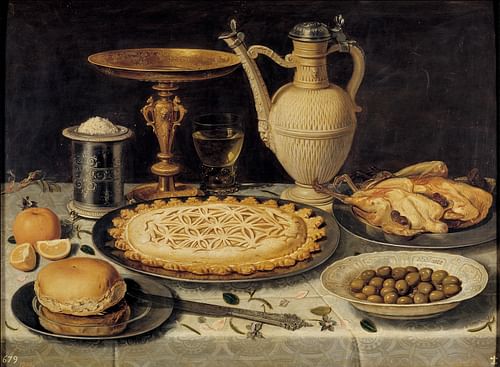
The First Course: Pottage or stewed broth; boiled meat or stewed meat, chickens and bacon, powdered [salted] beef, pies, goose, pig, roasted beef, roasted veal, custard.
The Second Course: Roasted lamb, roasted capons, roasted conies [rabbit], chickens, peahens, baked venison, tart.
(Singman, 132)
As can readily be seen, meat was eaten so frequently and in such prodigious quantities amongst the rich that they frequently suffered complaints like kidney and bladder stones, as well as urinary infections. The rich ate so well and over so many courses that their servants at least benefitted from this bonanza as they got to eat the leftovers; anything still left over was then given to the poor.
Cheese was eaten at the end of the main courses, as were nuts, especially chestnuts, walnuts, and hazelnuts. Sweet dishes, as seen in the above menu, were not necessarily reserved for the final part of the meal but might be served between savoury courses. Desserts included fruit, honey, pastries rich in butter, puddings using stale bread, biscuits, gingerbread, and all manner of cakes, fruit pasties and tarts made using refined sugar (by now being grown in the Americas but still expensive). Sugar was also used to make marmalade, jams, fruit conserves, marzipan, and sweets.
The Meals of the Commoners
Lunch was more important than dinner for commoners, and generally, all the food was served at the same time. Artisans and agricultural workers ate meat only on special occasions and instead they ate more bread, milk, cheese, and eggs. Bread was, however, another food item that depended on status as the best bread which used the finest, well-ground flour was more expensive. Consequently, the bread on a rich person's table was noticeably whiter than a loaf on a poor person's. The less well-off ate barley bread and rye bread which were very dark brown or almost black in colour. Bread was typically made into low round loaves of various sizes. For labourers, a packed lunch consisting of a chunk of bread, cheese, and large rigid pasties containing meat and/or vegetables would have seen them through their working day.
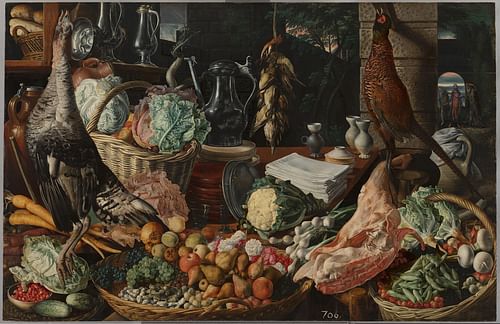
To make the best ordinary pottage, you shall take a rack of mutton cut into pieces, or a leg of mutton cut into pieces; for this meat and these joints are the best, although any other joint or any fresh beef will likewise make good pottage: and having washed your meat well, put it into a clean pot with fair water, and set it on the fire; then take violet leaves, endive, succory, strawberry leaves, spinach, langdebeef [oxtongue], marigold flowers, scallions and a little parsley, and chop them very small together; then take half so much oatmeal well beaten as there is herbs, and mix it with the herbs, and chop all very well together: then when the pot is ready to boil, scum it very well, and then put in your herbs, and so let it boil with a quick fire, stirring the meat oft in the pot till the meat be boiled enough, and then the herbs and water are mixed together without any separation, which will be after the consumption of more than a third part: then season them with salt, and serve them up with the meat either with snippets [thin slices of toasted or fried bread] or without.
(Singman, 143)
England was self-sufficient in terms of agricultural produce, although the run of bad harvests in the 1590s CE did necessitate the import of grain and prices tripled. Eggs were a favourite with everybody and added to a large number of dishes, as was lard which at least solved the problem of where to find protein and calories. The most commonly eaten vegetables were peas, beans, and lentils. Other common vegetables included spinach, artichokes, asparagus, carrots, and lettuce. In the 1580s CE, the potato had been introduced to England from the New World by Sir Walter Raleigh (c. 1552-1618 CE), but it remained an expensive delicacy and was yet to realise its full potential. Commonly cultivated fruits included apples, pears, grapes, plums, apricots, figs, strawberries, raspberries, and mulberries. For the rich, oranges, lemons, capers, and olives were imported from mainland Europe. As the Elizabethan period witnessed the so-called Little Ice Age, the winter season was markedly longer than in other eras greatly increasing the risk of scurvy as vitamin-rich fresh food became scarce. Consequently, whatever the season offered in terms of wild vegetables and fruits were well-received by everyone.
Beverages
Drinking water was avoided by most people as it was rarely ever clean and tasteless. Elizabethans were aware that water harboured disease (typhoid, cholera, and dysentery) and for this reason drank beer or ale made from malted barley, water, and added spices. Beer from hops was the cheapest drink because, having a higher alcohol content, it could be stored longer than any of the others; although finer beers were aged for up to two years before drinking. Ale was so light in alcohol it was drunk even by children but it could be strengthened, sometimes by as much as four times the norm, and this heady brew became known by various nicknames like 'Dragon's Milk' and 'Mad Dog'.
Wine, both plain and fortified, was also drunk, but as this was imported from Continental Europe and was exposed to import duties, it was not cheap. A bottle of wine cost around 12 times as much as a bottle of ale. France was the main source and came in two broad groups: from northern France and called simply 'French' wine and from the Bordeaux region when it was called 'Gascon' wine or claret. Other wines came from the Rhine area, Italy, and Greece. Three fortified sweet wines were popular: 'sack' from Jerez (which later became known as sherry), 'Madeira' from the Madeira Islands and 'Canary' from the Canary Islands. Other popular alcoholic drinks included cider, mead (honey wine), perry (from fermented pears), and 'raspie' made from raspberries. Just about any seasonal fruits - from gooseberries to elderberries - were used to make wines, although the quality must have been generally low and the taste an acquired one. Finally, spirits were made from distilled wine such as aqua vitae but these were largely used as a medicine, as was spiced wine.
If not drunk at home, alcoholic drinks were readily available at inns (which also served food), taverns (which did not usually serve food and whose clientele preferred wine), alehouses, and basic food-serving places known as 'ordinaries'. Both men and women attended all of these establishments. Another source was church ales, which were regularly organised by parish churches to raise funds for the upkeep of the church and to help the poor in the parish. Some church ales spanned across several days and two or three might be held annually. Food was available and entertainment such as players, wrestling and Morris dancing was provided but it was the attraction of the ale and the tendency for attendees to get a little carried away that so upset the Puritans towards the end of Elizabeth's reign.
